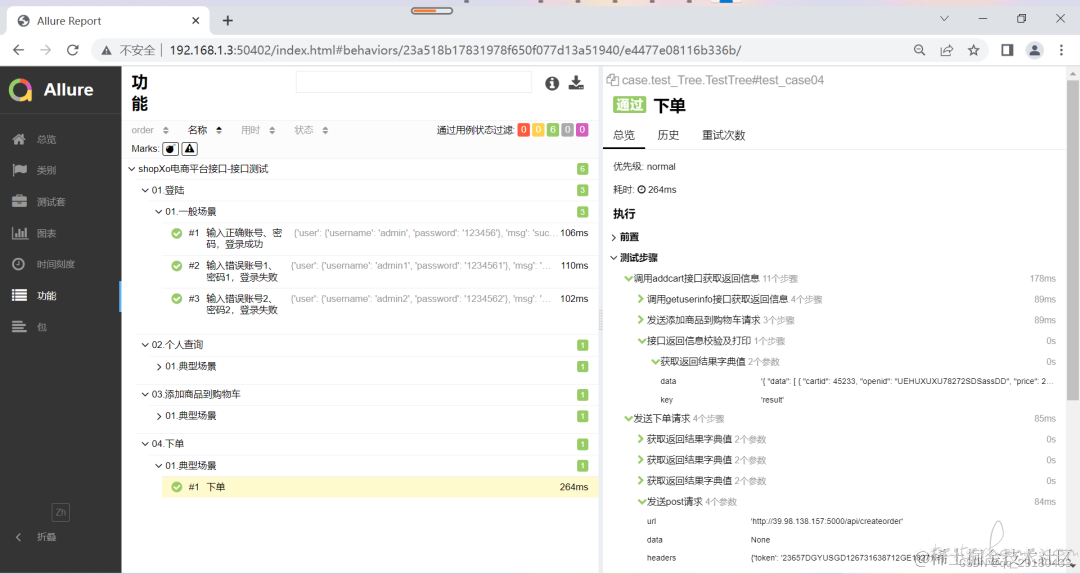一、整体结构
- 框架组成:pytest+requests+allure
- 设计模式:
- - 关键字驱动
- 项目结构:
- - 工具层:api_keyword/
- 参数层:params/
- 用例层:case/
- 数据驱动:data_driver/
- 数据层:data/
- 逻辑层:logic/
二、具体步骤及代码
1、工具层
将 get、post 等常用行为进行二次封装。
代码(api_key.py)如下:
import allure
import json
import jsonpath
import requests
# 定义一个关键字类
class ApiKey:
# 将get请求行为进行封装
@allure.step("发送get请求")
def get(self, url, params=None, **kwargs):
return requests.get(url=url, params=params, **kwargs)
# 将post请求行为进行封装
@allure.step("发送post请求")
def post(self, url, data=None, **kwargs):
return requests.post(url=url, data=data, **kwargs)
# 由于接口之间可能相互关联,因此下一个接口需要上一个接口的某个返回值,此处采用jsonpath对上一个接口返回的值进行定位并取值
@allure.step("获取返回结果字典值")
def get_text(self, data, key):
# json数据转换为字典
json_data = json.loads(data)
# jsonpath取值
value = jsonpath.jsonpath(json_data, '$..{0}'.format(key))
return value[0]
- 其中引用 allure.step() 装饰器进行步骤详细描述,使测试报告更加详细。
- 使用 jsonpath 对接口的返回值进行取值。
2、数据层
数据采用 yaml 文件。
代码(user.yaml)如下:
-
user:
username: admin
password: '123456'
msg: success
title: 输入正确账号、密码,登录成功
-
user:
username: admin1
password: '1234561'
msg: 用户名或密码错误
title: 输入错误账号1、密码1,登录失败
-
user:
username: admin2
password: '1234562'
msg: 用户名或密码错误
title: 输入错误账号2、密码2,登录失败
- 其中 title 是为了在用例进行时动态获取参数生成标题。
3、数据驱动层
对数据进行读写。
代码(yaml.driver.py)如下:
import yaml
def load_yaml(path):
file = open(path, 'r', encoding='utf-8')
data = yaml.load(file, Loader=yaml.FullLoader)
return data
4、参数层
参数层存放公共使用的参数,在使用时对其进行调用。
代码(allParams.py)如下:
'''python
规则:
全局变量使用大写字母表示
'''
# 地址
URL = 'http://39.98.138.157:'
# 端口
PORT = '5000'
5、逻辑层
用例一:进行登录的接口请求,此处登录请求在 yaml 文件里设置了三组不同的数据进行请求。
用例二:进行个人查询的接口请求,此处需要用到登录接口返回的 token 值。
用例三、进行添加商品到购物车的接口请求,此处需要用到登录接口返回的 token 值以及个人查询接口返回的 openid、userid 值
用例四、进行下单的接口请求,此处需要用到登录接口返回的 token 值以及个人查询接口返回的 openid、userid、cartid 值
注意:由于多数接口需要用到登录接口返回的 token 值,因此封装一个 conftest.py 定义项目级前置 fixture,在整个项目只执行一次,可以在各个用例中进行调用(其他共用参数也可以采取类似前置定义)。同时由于此处定义的项目级 fixture,因此可以将初始化工具类 ak = ApiKey() 也放入其中。
代码(conftest.py)如下:
from random import random
import allure
import pytest
from pytest_demo_2.api_keyword.api_key import ApiKey
from pytest_demo_2.params.allParams import *
def pytest_collection_modifyitems(items):
"""
测试用例收集完成时,将收集到的item的name和nodeid的中文显示在控制台上
"""
for item in items:
item.name = item.name.encode("utf-8").decode("unicode_escape")
item._nodeid = item.nodeid.encode("utf-8").decode("unicode_escape")
# 项目级fix,整个项目只初始化一次
@pytest.fixture(scope='session')
def token_fix():
# 初始化工具类
ak = ApiKey()
with allure.step("发送登录接口请求,并获取token,整个项目只生成一次"):
# 请求接口
# url = 'http://39.98.138.157:5000/api/login'
url = URL + PORT + '/api/login'
# 请求参数
userInfo = {
'username': 'admin',
'password': '123456'
}
# post请求
res = ak.post(url=url, json=userInfo)
# 获取token
token = ak.get_text(res.text, 'token')
# 验证代码,验证token只生成一次
token_random = random()
return ak, token, res, token_random
- 其中也包含了防止中文乱码,加入了 pytest_collection_modifyitems(函数)。
设置好 conftest 后,就可以应用在逻辑层里面了。
代码(shopingApi.py)如下:
import pytest
import allure
from pytest_demo_2.api_keyword.api_key import ApiKey
from pytest_demo_2.params.allParams import *
class ApiCase():
# 登录逻辑
def params_login(self, userdata):
# 动态获取参数生成标题
allure.dynamic.title(userdata['title'])
# 初始化工具类
ak = ApiKey()
# 请求接口
url = URL + PORT + '/api/login'
# 请求参数
userInfo = {
'username': userdata['user']['username'],
'password': userdata['user']['password']
}
res = ak.post(url=url, json=userInfo)
with allure.step("接口返回信息校验及打印"):
print("/api/login登录接口请求响应信息")
print(res.text)
# 获取响应结果
msg = ak.get_text(res.text, 'msg')
print(msg)
# 断言
assert msg == userdata['msg']
def params_getuserinfo(self, token_fix):
# 从fix中获取预置的工具类和token,所有返回值都需要接收
ak, token, res, token_random01 = token_fix
with allure.step("发送个人查询接口请求"):
url = URL + PORT + '/api/getuserinfo'
headers = {
'token': token
}
res1 = ak.get(url=url, headers=headers)
with allure.step("接口返回信息校验及打印"):
print("/api/getuserinfo个人用户查询接口请求响应信息")
print(res1.text)
# print("验证的random值,测试用")
# print(token_random01)
name = ak.get_text(res1.text, 'nikename')
# 断言
assert "风清扬" == name
return res1
def params_addcart(self, token_fix):
# 从fix中获取预置的工具类和token
# 所有返回都要获取,不然会报错
ak, token, res, token_random01 = token_fix
with allure.step("调用getuserinfo接口获取返回信息"):
res1 = self.params_getuserinfo(token_fix)
with allure.step("发送添加商品到购物车请求"):
# 添加商品到购物车,基于token、userid、openid、productid
url = URL + PORT + '/api/addcart'
hd = {
"token": token
}
data = {
"userid": ak.get_text(res1.text, 'userid'),
"openid": ak.get_text(res1.text, 'openid'),
"productid": 8888
}
# 发送请求
res2 = ak.post(url=url, headers=hd, json=data)
with allure.step("接口返回信息校验及打印"):
print("/api/addcart添加商品到购物车请求响应信息")
print(res2.text)
# print("验证的random值,测试用")
# print(token_random01)
result = ak.get_text(res2.text, 'result')
assert 'success' == result
return res2
def params_createorder(self, token_fix):
ak, token, res, token_random01 = token_fix
with allure.step("调用addcart接口获取返回信息"):
res1 = self.params_addcart(token_fix)
with allure.step("发送下单请求"):
url = URL + PORT + '/api/createorder'
# 从项目级fix中获取token
hd = {
"token": token
}
# 从添加商品到购物车接口中获取userid,openid,cartid
data = {
"userid": ak.get_text(res1.text, 'userid'),
"openid": ak.get_text(res1.text, 'openid'),
"productid": 8888,
"cartid": ak.get_text(res1.text, 'cartid')
}
res2 = ak.post(url=url, headers=hd, json=data)
with allure.step("接口返回信息校验及打印"):
print("/api/createorder下单请求响应信息")
print(res2.text)
# print("验证的random值,测试用")
# print(token_random01)
result = ak.get_text(res1.text, 'result')
assert 'success' == result
6、用例层
调用逻辑层进行用例管理和数据传输。
代码(test_Tree.py)如下:
import allure
import pytest
from pytest_demo_2.data_driver import yaml_driver
from pytest_demo_2.logic.shopingApi import ApiCase
@allure.epic("shopXo电商平台接口-接口测试")
class TestTree():
# 初始化用例库
actions1 = ApiCase()
@allure.feature("01.登陆")
@allure.story("02.一般场景")
@user8ize('userdata', yaml_driver.load_yaml('./data/user.yaml'))
def test_case01(self, userdata):
self.actions1.params_login(userdata)
@allure.feature("02.个人查询")
@allure.story("01.典型场景")
@allure.title("个人查询")
def test_case02(self, token_fix):
self.actions1.params_getuserinfo(token_fix)
@allure.feature("03.添加商品到购物车")
@allure.story("01.典型场景")
@allure.title("添加商品到购物车")
def test_case03(self, token_fix):
self.actions1.params_addcart(token_fix)
@allure.feature("04.下单")
@allure.story("01.典型场景")
@allure.title("下单")
def test_case04(self, token_fix):
self.actions1.params_createorder(token_fix)
7、运行
代码(main_run.py)如下:
import os
import pytest
def run():
pytest.main(['-v', './case/test_Tree.py',
'--alluredir', './result', '--clean-alluredir'])
os.system('allure serve result')
# os.system('allure generate ./result/ -o ./report_allure/ --clean')
if __name__ == '__main__':
run()
8、结果

转载文章时务必注明原作者及原始链接,并注明「发表于 TesterHome 」,并不得对作品进行修改。
